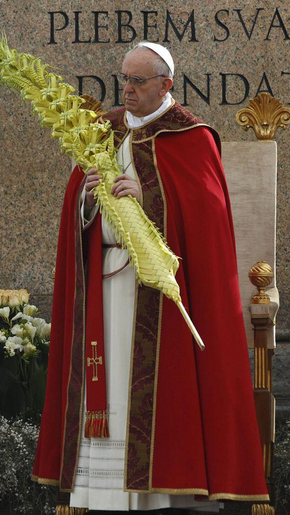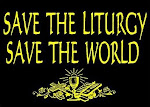
In an interview with Fr. Thomas Crean, Ignatius Insight discusses the Father's new book, The Mass and the Saints. To my mind, Father Crean explained well the reason he wrote the book in this short statement:
I wanted to offer my own contribution to the "liturgical debate" which is prominent in the Church today; it seemed to me that those who had participated in the sacred liturgy with the greatest love—the saints—were best able to teach us how to think about it.
Considering the fact that great numbers of modern Catholics hold the "Mass of the Ages" in derision, if not outright contempt, I often wonder how much thought is given to the fact that the "Mass of the Ages" was also the "Mass of the Saints." What would you imagine the Saints might think of the "reformed" liturgy? This is a question for which all modern day Catholics ought to be able to provide a satisfactory answer.
Here's the text of the interview:
Ignatius Insight: What inspired you to write this book, a compilation of quotes by saints (and near saints) about the Mass?
Fr. Crean: It started off as a translation of St Albert the Great's commentary on the Mass, a long work called De Sacrificio Missae, which as far as I know has never been translated into English. Part way through I realised that St Albert's style was too prolix for modern tastes and that a simple translation was unlikely to appeal to a wide authorship.
Nevertheless, I had discovered many passages which I found striking or beautiful, and which I did want to make available in English. At the same time I had been thinking of putting together a compendium of Eucharistic quotations from St Thomas Aquinas' writings, illustrated with pictures. The two projects merged, and then I realised that there was no reason to stop with St. Albert and St. Thomas, but that I could try to find as many different "voices" as possible, to produce something like a symphony in words. My inspiration was the Catena Aurea: the commentary on the four gospels which St Thomas put together out of the works of the Fathers and some slightly later writers such as Alcuin of York. I say this was my inspiration: it would be presumptuous to say that it was my model.
More generally, I wanted to offer my own contribution to the "liturgical debate" which is prominent in the Church today; it seemed to me that those who had participated in the sacred liturgy with the greatest love—the saints—were best able to teach us how to think about it.
Ignatius Insight: How did you go about selecting the various quotes? Did you have a certain criteria in mind?
Fr. Crean: I made use of what I had to hand, first in the library of the Dominican priory where I was living, then in the library of the University of Cambridge. The standard reference books on the history of the Mass helped me to orient myself, especially in regard to the Fathers of the Church; other works I came across by chance, for example the sermons of St Vincent Ferrer.
I was looking for quotations that would be beautiful or striking. As I wrote in the preface, I wanted to produce a book that would aid "meditation and devotion". I was also looking to show the continuity of the Church's faith through time, so I made a point of trying to give quotations from every century. At the same time, I gave a certain preference to the earlier centuries, as having more innate authority, and to the doctors of the Church. Again, I was looking both for quotations that would give a straightforward account of why some phrase or ceremony appeared in the Mass, and for quotations which would give a more mystical interpretation of the action of the Mass, as the Catena Aurea gives both a literal and mystical commentary on the gospels.
I also included some quotations to show how some problems that we might think of as particularly modern were not unknown in the past, for example chatting in church. So, there were a number of different criteria in play.
Ignatius Insight: In addition to well-known saints such as St. Thomas Aquinas, St. Francis de Sales, and St. Augustine, there are many names that aren't nearly as familiar. Who are some of those authors? Do you have some personal favorites?
Fr. Crean: Two non-canonised authors who appear quite a lot are Amalarius and Durandus. Amalarius was a ninth-century bishop who had studied under Alcuin of York. He had a particular gift for giving mystical interpretations of the ceremonies of the Mass. He is not popular with everyone, but I found him inspiring. Durandus was a great compiler. He lived in the thirteenth century, and wrote a massive work called the Rational of Divine Offices, where he gives exhaustive explanations, both literal and mystical, for all that is done in the Mass, the sacraments and the liturgy of the hours. It's a treasure trove, but only a small part has ever been translated into English.
A much more famous author, but one whom I hadn't studied before preparing this book, is St Robert Bellarmine. I particularly appreciated the care with which he explains the words of the Roman Canon, in his defence of the Mass against the early Protestants.
Very short descriptions of all the authors cited are given at the back of the book, along with references to the principal sources used. Sometimes I made discoveries that surprised me. Isaac of Stella, for example, appears in the modern breviary, and I had always supposed that he must have lived somewhere in the Middle East. In fact he was a monk from the north of England!
Ignatius Insight: Obviously there is much to be learned about worship, the Mass, and the Eucharist from the saints. What are some of the essential lessons they can either teach us or remind us of?What are some of the notable differences between how, say, a thirteenth-century or sixteenth-century Catholic approached the Mass and how Catholics generally approach it today?
Fr. Crean: I suspect that many Catholics come to Mass today to listen to the readings (and sermon) and to receive Holy Communion. Those are both excellent reasons, of course, but neither corresponds to what is most proper to the Mass, since one can listen to Scripture and even receive Communion at other times. What is most proper to the Mass is that it is the sacrifice which is offered to God under the New Covenant. I think that this was better understood in past times. I hope that some of the quotations included in the book can help to renew an understanding of this: that was why I began with a section called "the Sacrifice", before passing to the various parts of the Mass itself.
Ignatius Insight: What are some of the reoccurring or prevalent themes that emerge in these texts? Are there any that might be new or even surprising to modern-day readers?
Fr. Crean: One prevalent theme that might be surprising to modern readers is the very idea of a "mystical sense" to the Mass, the idea that the Mass is a recapitulation of the life of the incarnate Word, from the nativity to the Ascension, or even a recapitulation of the whole of sacred history. So the introit, for example, would represent the desire of the fathers for the coming of the Redeemer, the Gloria his birth, the Gospel his public preaching and so on. This idea is worked out slightly differently by different authors, but there is a basic unity of approach within the Church's tradition.
As I indicated above in connection with Amalarius, some 20th Century liturgists did not like this idea, rejecting it as arbitrary or whimsical; but I think that in doing so they miss part of the full splendour of the Mass as willed by God. Such mystical interpretation, incidentally, lends itself more to the usus antiquior than to the Mass of Paul VI, because of the more unchanging nature of the former; also, the mystical interpretations were largely fixed by the mediaeval writers, who were commenting, of course, on the pre-Vatican II Ordo.
Ignatius Insight: Having studied and reflected on the many thoughts of saints and doctors about the Mass, what do you hope readers will gain from your book?
Fr. Crean: I hope that they will grow in love for the holy Mass, the product, as Blessed Isaac of Stella puts it, "of divine power and human care". And if they do, perhaps they might say a prayer for me when they take part in the mysteries.
















